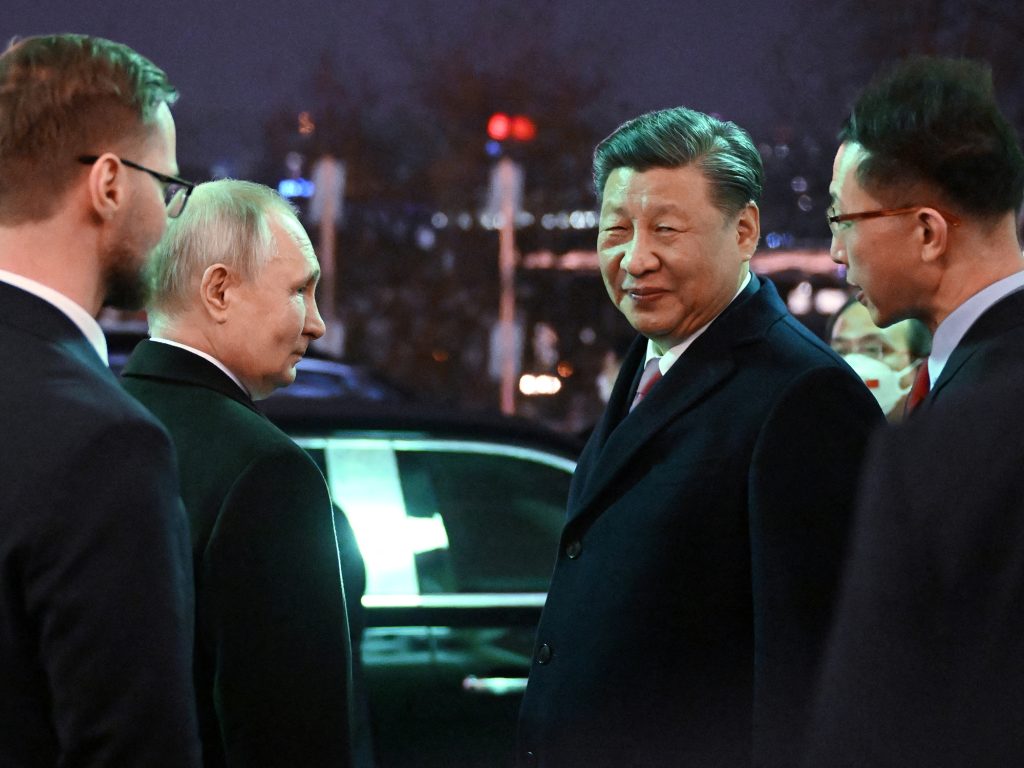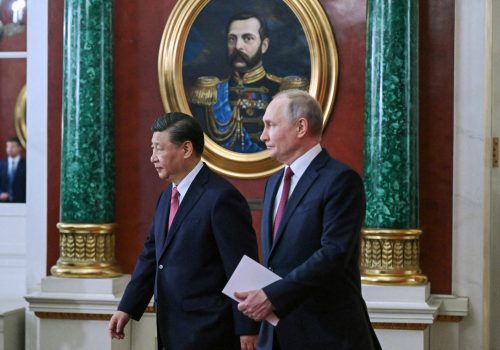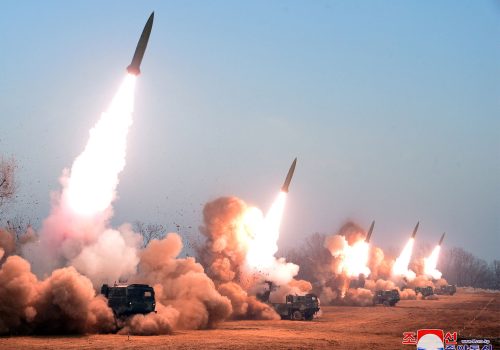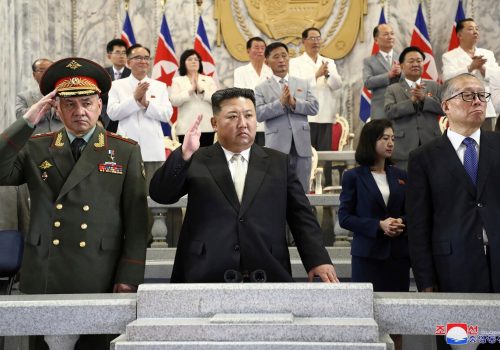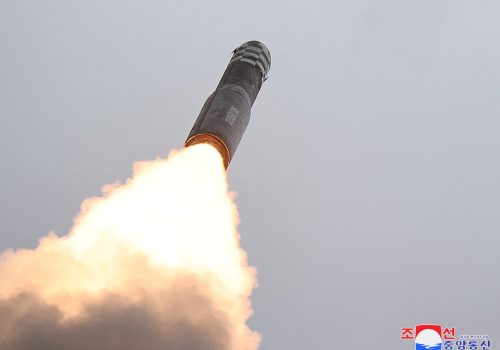Just over a year ago, the US military began rewriting its Cold War-era nuclear deterrence theory. The impetus: The rise of two peer nuclear competitors—Russia and China—according to former US Strategic Command Commander Admiral Charles Richard.
That arrival has come clearer into focus as Russia has expanded and modernized its nuclear arsenal—and resorted to nuclear saber-rattling in an attempt to achieve its objectives in Ukraine. China has also expanded and modernized its nuclear program, and the US Department of Defense has estimated that China’s nuclear arsenal will likely grow to at least 1,500 deliverable warheads by 2035 if its buildup continues at its current pace.
The tripolar nuclear power world is certainly new; but the deterrence theories of the Cold War may not need to be completely changed. In a summer roundtable discussion, fellows from Forward Defense’s Nuclear Strategy Project concluded that, while the world has changed over the last seventy-five years, reflecting on how the United States approached nuclear deterrence in the Cold War era can yield insights for policymakers in crafting a new deterrence theory.
Deterrence theory has remained the same—but the United States’ execution must change
During the Cold War, the United States had to determine how to deter nuclear attacks on its territory, how to extend deterrence to cover allies, and how to manage the risk of nuclear escalation in any conflict.
To deter nuclear attacks against the United States and its allies, the United States deployed a robust nuclear triad of strategic nuclear forces (with components that could survive a first strike from the Soviet Union and retaliate with devastating consequences) and tactical nuclear weapons, which Washington forward deployed in regions such as Europe and South Korea. By doing so, the United States maintained its capability to use nuclear weapons first to deter a possible conventional Soviet invasion of NATO allies in Western Europe.
According to Keir Lieber, a fellow with Forward Defense, the United States does not need a “fundamentally new theory” to deter an attack on US soil or to extend deterrence and assurance—despite the fact that extending deterrence to allies has gotten more difficult. However, Lieber also said he believes that Cold War theories and ideas are hindering the United States’ ability to “think clearly and realistically” about deterring and managing escalation in a conventional war.
While the fundamentals of deterrence remain the same, the new strategic environment means that the United States and its allies must execute that strategy differently. During the Cold War, the United States executed its deterrence strategy to make credible threats that it would use nuclear weapons if its conventional forces were to fail in war. But today, US first use is much less likely, and Washington instead must look to deter its adversaries in conventional war to stop them from escalating to a nuclear level: in other words, stopping adversaries from resorting to first use to win the war. “The analytical community for thirty years was focused on one problem in the Cold War. It is focused on a different problem today,” explained Forward Defense fellow Daryl Press. Recognizing this change in the relationship between nuclear and conventional activity could help the United States execute its deterrence strategy in a way that fits the new strategic environment.
Read the transcript of the event
The United States will need to adopt a flexible stance in confronting a new nuclear challenge
During the Cold War, the United States ultimately settled on a flexible response strategy in which it ensured that it had several options—both non-nuclear and nuclear—to respond to aggression or restrict an adversary from escalating. Having several options, rather than a singular outlined response, gave the US deterrent more credibility.
Flexible response more or less remains US policy today, as shown in both the 2018 and 2022 Nuclear Posture Reviews. This policy is challenged by adversaries developing more flexible nuclear options that have outpaced those of the United States. Atlantic Council Board Director Walter Slocombe (who sponsored the roundtable) pointed out that during some parts of the Cold War, US nuclear war plans did not correspond to nuclear strategies articulated in higher-level political guidance, and the doctrines written by the administration often had minimal impact on the actual war plans being employed by the Department of Defense. For example, early Cold War nuclear plans tended to favor massive retaliation, despite overall strategy guidance toward graduated escalation.
Today, the United States faces the problem of how to stop its adversaries from using nuclear weapons if the United States is winning a conventional war. Even though the United States faces the prospect of a limited nuclear strike, it should not change its principal goal: It should still seek to restore deterrence while inflicting minimal damage and pursuing US and allied political objectives. Showing resolve is important in responding to adversary nuclear use; but showing restraint is necessary in ending escalation. “Suicide cannot be the president’s only deterrent option,” explained General Kevin Chilton, a Forward Defense distinguished fellow.
As the United States enters an era with two peer nuclear adversaries, it should take an even more flexible stance. For example, in deterring a regional conflict, threatening to strike a near-peer adversary could push that adversary to respond in a similar, if not escalated, fashion. According to Chilton, the current US nuclear triad is essentially a dyad today. Although the bomber force remains flexible (and could be used in a theater role), it is difficult to put on alert, explained Chilton, and the submarine and land-based missile legs of the nuclear triad do not provide the same theater-based response options as the bomber leg could.
Furthermore, in the Cold War era, the United States adhered to a strategy—Presidential Directive 59—that included a secure reserve force. These secure reserve forces, according to Slocombe, could act “as a way of deterring, still by the threat of retaliation [further escalation by the enemy], because of the prospect that [the United States] can still trump his ace.” If faced with a nuclear attack, the resilience of the US nuclear force would be sufficient to withstand the assault, ensuring the ability to respond significantly and thus deter potential attackers. However, if the United States has to simultaneously engage with both Russia and China, the situation becomes even more difficult. If China and Russia collaborate or one exploits vulnerabilities in the aftermath of an attack by the other, the United States will require a more adaptable and resilient range of options to effectively address this situation.
The United States will also need to be flexible to confront the problem of less-than-peer competitors
Cold War deterrence theory does not adequately outline how to address less-than-peer competitors. During the Cold War, the United States needed principally to deter a possible nuclear attack from the Soviet Union. Countries like North Korea—and, possibly in the future, Iran—cannot be viewed in the same way. These countries do not have peer-level nuclear arsenals, but the presence of a nuclear arsenal in any capacity may complicate the United States’ regional thinking. Washington must figure out how to manage escalation dynamics: Flexibility will be key.
According to Press, it is impossible to deter such countries from nuclear escalation during a conventional war in the same way the United States deterred the Soviet Union in the Cold War. If North Korean leader Kim Jong Un believes that a conventional war with the United States could result in his loss of power or even death, he may be strongly incentivized to escalate to nuclear weapons use even in the face of likely retaliation, Press explained. For that reason, threatening a regime-ending strike may not be adequate to deter North Korean—or, possibly in the future, Iranian—nuclear use. Instead, the United States must have even more flexible options—ones that not only punish but also disarm adversaries—than it has today.
The United States will need to balance its strategy to extend deterrence to allies—but what worked in the past may not work now
Hans Binnendijk, a distinguished fellow at the Atlantic Council’s Transatlantic Security Initiative, outlined “four Ts” that comprised the United States’ successful extended-deterrence strategy during the Cold War: US treaty arrangements with its allies, regionally deployed troops (which acted both as conventional defenses and as escalatory tripwires), theater nuclear weapons, and, most importantly, trust with its allies. According to Binnendijk, “these ‘four Ts’ together allowed the United States to get through the Cold War with extended deterrence working.”
While the “four Ts” have remained the backbone of extended deterrence, Binnendijk argued, the United States cannot assume the current balance of these elements will continue to work in the future. Trust in the United States’ extended deterrence is at risk of being eroded as the threat of crises that could lead to nuclear escalation rises, as the United States continues to adjust its theater-deployed nuclear weapons (it essentially eliminated its theater-deployed nuclear weapons after the end of the Cold War and currently deploys no land-based, nuclear-capable missiles in Europe or Asia), and as Russia and China expand their regional missile arsenals.
Trust between the United States and its allies remains the most important element of extended deterrence and requires consistent maintenance. As Atlantic Council Board Director Franklin Kramer pointed out, during the Cold War, there were moments when that trust wavered—it was not, as he said, that extended deterrence worked perfectly, but it did not fail. Therefore, the United States cannot take the credibility of its extended deterrence guarantees for granted and must work to maintain the trust of its allies in this new nuclear era.
Fortunately, the mutual defense treaties between the United States and its allies have remained intact, and the Biden administration has recently taken visible steps to increase consultation on nuclear issues with Japan and South Korea. Other work is already underway to enhance the “four Ts” of deterrence, according to Binnendijk. For example, Sweden’s pending and Finland’s completed accession to NATO will extend the US nuclear umbrella to additional allies. In the Indo-Pacific, the Nuclear Consultative Group with the Republic of Korea will help enhance trust.
But still, the challenge of a two-peer nuclear scenario introduces complexities that these measures may not effectively tackle. The United States faces the task of assuring partners in two distinct theaters. In Europe, where concerns may revolve around Russian aggression, and in the Indo-Pacific, where the focus might be on China or threats from North Korea, tailored approaches are essential. While enhancing assurance among NATO allies could involve a collective review of nuclear deterrence capabilities within the NATO Nuclear Planning Group, addressing the Indo-Pacific dynamics may necessitate different political considerations. Engaging in bilateral consultations or, as suggested by Binnendijk, returning US nuclear weapons to the region might even be required for extended deterrence.
The United States will need to lay significant groundwork before it can achieve arms-control goals with China
Arms control involves more than legally binding treaties that limit or reduce nuclear weapons. According to Forward Defense Fellow Amy Woolf, most of the treaties that the United States signed during the Cold War did not require reductions in nuclear weapons; reductions followed changes in requirements late in the 1980s. Looking at arms control and risk reduction beyond these legally binding treaties, according to Woolf, is the most viable approach to arms control today.
When the United States began discussions with the Soviet Union in the 1960s, the two countries had very different perspectives on the role of nuclear weapons, strategic stability, and nuclear competition itself. Even though neither Washington nor Moscow was able to change the other’s mind during the course of their early talks, such discussions helped them understand each other’s perspectives—which led to many of the arms control arrangements that came to exist.
In the post-Cold War era, the United States cannot expect its relationship with China to be in the same place as it was with the Soviet Union and Russia. The toolkit the United States established with the Soviet Union (and Russia after the USSR’s collapse) took more than fifty years to build. Nonetheless, Washington should not be deterred from attempting to build lines of communication with Beijing. According to Forward Defense Fellow Rachel Whitlark, one key takeaway from the Cold War is that, over time, two competitors managed to figure out how to cooperate on areas of mutual interest, despite ongoing competition and contestation because they were able to engage with one another and manage instability. The United States should therefore keep lines of communication open with China.
The United States needs to develop its strategic deterrent—in terms of policy, capabilities, and diplomacy—to suit today’s strategic environment. The emerging two-nuclear-peer problem, created by China’s nuclear breakout, makes possible scenarios like simultaneous aggression that did not feature principally during the Cold War. Nevertheless, reflecting on Cold War deterrence theory offers policymakers valuable lessons that could prepare the United States to face up to the tripolar nuclear power world.
Alyxandra Marine is an assistant director in the Forward Defense practice at the Atlantic Council’s Scowcroft Center for Strategy and Security.
Further reading
Thu, Nov 9, 2023
Deterrence is crumbling in Korea: How we can fix it
Report By Markus Garlauskas, Lauren D. Gilbert
Conventional wisdom in the United States holds that deterrence in Korea is strong, but this widespread confidence is based on a backward look at long-standing assumptions that are no longer tenable, along with rapidly shifting politico-military conditions. This report explains the urgent actions required to get ahead of these changes and maintain effective deterrence.
Fri, Oct 13, 2023
What needs to change about US nuclear weapons strategy?
New Atlanticist By
Our experts break down the 2023 Congressional Commission on the Strategic Posture of the United States report.
Wed, Aug 16, 2023
The United States and its allies must be ready to deter a two-front war and nuclear attacks in East Asia
Report By Markus Garlauskas
This report highlights two emerging and interrelated deterrence challenges in East Asia with grave risks to US national security: 1) Horizontal escalation of a conflict with China or North Korea into simultaneous conflict; 2) Vertical escalation to a limited nuclear attack by either or both adversaries to avoid conceding.
Image: Russian President Vladimir Putin and Chinese President Xi Jinping leave after a reception in honor of the Chinese leader's visit to Moscow on March 21, 2023. Photo via Sputnik/Grigory Sysoev/Kremlin via REUTERS.
